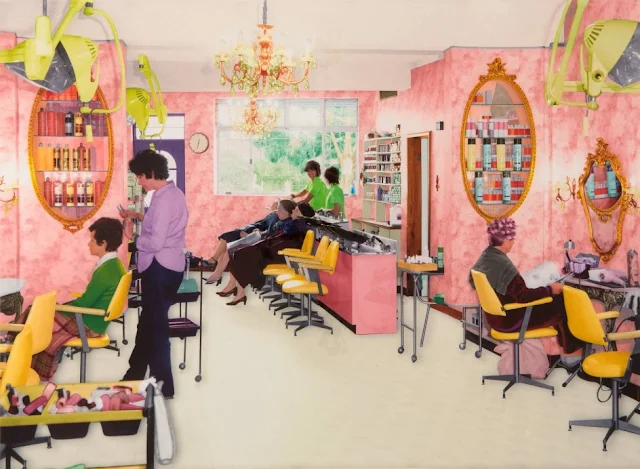Exploring the Poetic and Provocative World of One of Australia's Most Influential Artists
Tracey Moffatt is a name that resonates deeply in the art world, celebrated for her ability to weave rich narratives that explore identity, memory, and cultural dislocation. Her work, which spans photography, film, and video art, defies traditional storytelling, offering instead a tapestry of emotions, histories, and fragmented tales that challenge and enchant her audience. As one of Australia’s most accomplished contemporary artists, Moffatt’s art invites us into spaces where personal and collective memories collide, creating a powerful dialogue between the past and present.
 |
| Tracey Moffatt - Something More #1 |
A Personal Lens on Universal Themes
Born in Brisbane in 1960, Moffatt’s Indigenous heritage plays a significant role in her art, infusing her works with themes of cultural belonging, colonial history, and racial identity. While her narratives are often deeply personal, they resonate universally, touching on themes of displacement, resilience, and the complexities of human relationships. Her photographs and films frequently explore childhood memories, familial ties, and the haunting legacy of Australia’s colonial past, yet they are never confined to a single interpretation.
Moffatt’s early works, such as her groundbreaking 1989 photographic series Something More, set the tone for her career. The series, composed of staged, cinematic tableaux, presents a young woman’s journey of ambition and escape. The vivid colors and dramatic settings evoke the golden age of Hollywood, but beneath the glossy surface lies a darker undercurrent of loss and longing. This juxtaposition of glamour and despair is a recurring motif in Moffatt’s work, reflecting the complexities of aspiration and identity.
 |
| Tracey Moffatt - Something More #9 |
The Power of Storytelling Through Staged Imagery
Moffatt’s art often blurs the boundaries between reality and fiction. Her photographic series Scarred for Life (1994) uses staged, snapshot-style images to mimic the aesthetics of family photo albums while telling unsettling stories of trauma and vulnerability. Each image is paired with a short, ambiguous caption that hints at moments of conflict, fear, or alienation. This series, like much of her work, invites viewers to fill in the gaps, creating their own narratives from the fragments she provides.
In her later series, such as Up in the Sky (1997), Moffatt adopts a more documentary-like approach, capturing stark, monochromatic images of life in rural Australia. While these images appear more straightforward, they are no less layered, revealing the tensions and contradictions of Australian society, particularly in relation to its treatment of Indigenous communities.
 |
| Tracey Moffatt -First Jobs, Hair Washer 1976 |
Film and the Poetics of Moving Images
Moffatt’s foray into film and video art further amplifies her storytelling prowess. Works like Night Cries: A Rural Tragedy (1989) and Bedevil (1993) showcase her ability to use sound, movement, and visual composition to evoke deep emotional responses. Night Cries, a haunting, visually striking short film, explores the strained relationship between an Aboriginal woman and her dying adoptive mother, blending surreal imagery with poignant themes of care, loss, and identity.
Her feature-length film Bedevil pushes the boundaries of traditional filmmaking, presenting three ghost stories inspired by Australian folklore and her own childhood experiences. The film’s dreamlike quality and non-linear narrative reflect Moffatt’s fascination with the interplay between memory and imagination.
 |
| Tracey Moffatt - Fourth #20 |
Cultural Critique and the Role of the Artist
Moffatt’s work is not only deeply introspective but also boldly critical of societal structures and cultural stereotypes. Through her art, she challenges the romanticized depictions of Australia and its history, exposing the often-overlooked realities of its Indigenous peoples. She tackles issues of race, gender, and class with a subtlety that avoids didacticism, instead encouraging viewers to confront their own biases and preconceptions.
Her photographic series Plantation (2009) and Spirit Landscapes (2013) delve into the intersections of place and history, exploring themes of labor, spirituality, and the lingering shadows of colonialism. These works reflect her ability to engage with complex socio-political issues while maintaining a poetic and visually arresting aesthetic.
Legacy and Influence
Tracey Moffatt’s art has earned her international acclaim, with her work featured in prestigious exhibitions such as the Venice Biennale, where she represented Australia in 2017. Her influence extends beyond her own practice, inspiring a generation of artists to embrace the power of storytelling and to use art as a means of cultural critique and self-expression.
Moffatt’s enduring appeal lies in her ability to transcend boundaries, of genre, medium, and cultural identity, while remaining deeply rooted in her personal experiences and heritage. Her work is a testament to the transformative power of art, offering not just a reflection of the world but a reimagining of it.
The Art of Tracey Moffatt
Tracey Moffatt’s art is a vivid reminder of the complexities of human experience and the profound ways in which memory and identity shape our understanding of the world. Through her evocative imagery and compelling narratives, she invites us to look beyond the surface, to question, to feel, and to imagine. Her work is not merely to be seen but to be experienced, lingering in the mind long after the encounter. Moffatt’s legacy is one of fearless creativity, a celebration of storytelling in its most potent and poetic form.



.jpg)







No comments:
Post a Comment